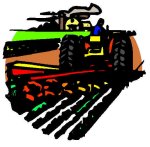

To send a message to an author, click on the author's name at the end of the article.
This Month in Ag Connection | Ag Connection - Other Issues Online]

When was the last time you put significant thought and effort into the long-range goals of the farm business? At some point, you should pause to really study and think about where you want the farm business to be in 5 years, 10 years, or 25 years. How will you get there?
Typically, the winter season is the time to do planning and paperwork. Given the changing nature of agriculture, a tool to consider is a business plan written specifically for your farm.
A business plan describes how the business is structured and operated along with future plans. Business plans generally contain the following four sections.
Description of the Business
This section includes descriptive items such as the legal business name, owners and
address information. Another item is the description of your location. This includes legal
descriptions and physical locations, as well as needs for changes/improvements. This is
also the section in which the commodity(s), product(s) or service(s) are described in
detail. Additional information may be - Why is your product unique?
The Marketing Plan
The marketing plan contains goals concerning selling strategies. All marketing
alternatives need to be evaluated and appropriate strategies implemented. Any direct
competition needs to be recognized and should be viewed as a source of information,
observing what works and what fails. The marketing section can also include advertising
and public relation activities. Your product(s) will determine if advertising is
necessary. For example, if the product is contract hogs, advertising probably is not
necessary, but if the product is replacement heifers, then advertising is essential.
Public relations are important for any business. Public relations could be as simple as
sponsoring a trophy at a local county fair to as in-depth as joining an organization and
working on national issues.
The Operational Management Plan (land, labor, and capital)
This section accounts for all the human and production resources. Job responsibilities are
assigned and plans for emergencies are developed. Identify each person's strengths and
weaknesses and determine how to maximize the resources for the business.
This section will also identify how land and capital will be utilized to meet the goals and objectives of the business. Enterprises and production processes are defined, along with utilization of capital assets.
The Financial Management Plan
Farm records and accounting are a part of financial management. Future financial needs of
the farm business are identified. Financial records include a projected budget, balance
sheet, depreciation schedule, cash flow statement and profit/loss statement.
The plan needs to be routinely reviewed and updated to account for changes in the business. If all members of the farm business have an understanding of the goals and the plans to reach them, everyone can work more efficiently and be more productive.
Resources: U.S. Small Business Administration
(Author: Mary Sobba, Farm Management Specialist)
This Month in Ag Connection | Ag Connection - Other Issues Online]

A good lease is defined as one in which both landowner and tenant are satisfied that it is equitable. While problems can occur when one party becomes dissatisfied with the amount of cash rent or crop/cost shares, more often it is the result of a misunderstanding about details or the "little things" that cause problems to develop.
"My tenant is taking advantage of me!" -- Landowner concerns the tenant should consider.
Appearance of the property and crops is typically important to the landowner. Mowing weeds
around buildings, field edges, and roadways may be important to how the landowner sees the
tenant taking care of the property. These expectations are often overlooked during lease
negotiations and may not be specified in the lease.
The use and compensation for machine sheds, grain bins or livestock facilities are often overlooked when leases are negotiated. The tenant may just assume that these go with the property while the landowner sees an investment that the tenant is getting for nothing! In some cases trades are appropriate. For example, the tenant might mow weeds in exchange for use of a machine shed.
Additional misunderstandings often occur when a spouse or the younger generation inherits the farm and weren't involved in the original lease discussions. Many times they look at the market value of the property and the amount of rent income and wonder why there is such a low return on capital. These things often lead them to conclude, "My tenant must be cheating me!" Changing farming practices or different enterprises may also cause concern. The heirs may look at no-till fields or a deteriorating unused livestock facility and say, "That's not the way it used to look!" It is very important for tenants to understand these concerns and communicate with the heirs, especially if they are unfamiliar with current farming practices or how farmland is typically leased.
"My landlord is unreasonable!" -- Tenant concerns the landowners should consider.
Timeliness of operations is important. However, landowners should realize that the tenant
may rent farms from several other landlords; they can't all be first! The landowner
hould discuss this with the tenant and reach an understanding about timeliness of
operations that is workable for the tenant.
Some things may not be useful to the tenant. While a large lake may add beauty and value to the farm, it may be of no value to the tenant's use of the property. Obsolete buildings, even if they are in excellent shape, generally are of little use to the tenant. Some property characteristics may be a negative to the tenant. For example, narrow gates create a problem for a tenant with large machinery, regardless of how new or how good the fences are. It is important for landowners to understand how the tenant is using the property -- not how they had used it.
In general, while landowners are justified in expecting tenants to maintain and care for the property, the landowner should not expect the tenant to make major improvements or long-term investments without compensation or special arrangements. Who is responsible, along with what they are responsible for, when fences or buildings need repair and other property maintenance or construction is required should be included in lease negotiations and the lease agreement.
Long term expenses such as lime often cause problems. In the past it was a common custom for the landowner to pay for lime since it was a multi-year expense and considered part of the base fertility of the soil rented to the tenant. Some landowners are now reluctant to make this expenditure since the tenant's crops benefit, especially if it is a cash lease. In this case the tenant might agree to pay for lime if the landlord agrees to reimburse for the "unused" portion if the lease is not renewed.
Many problems and misunderstandings can be prevented with a written lease.
Unfortunately, many farms are rented using only an oral agreement. Some think that
suggesting a written lease will be interpreted as a sign of mistrust. Trust is not the
issue! A written lease won't make a dishonest person honest and it is probably unwise to
enter a lease with someone who can't be trusted regardless of whether it is written or
not. A written lease protects both the landowner and the tenant. A good written lease
spells out the details of the rent amount or share, uses of the property, and each party's
responsibilities along with any special agreements. A lease protects the heirs of both
parties and provides them with the details of the agreement.
The process of preparing a written lease forces both sides to think about the details. This alone often justifies preparing the written lease. Discussing and putting into a written document agreements about maintenance or repairs and bin or building rents along with details about care and use of property avoids many problems and misunderstandings that could occur later.
Finally, just communicating with each other and trying to understand the other party's concerns can solve many problems.
The tenant should respect the landowner's concerns and try to care for the property in an
acceptable manner. Tenants should also take the time to explain their plans for the
property, especially if the owners are not familiar with current practices. If both
parties are reasonable, communication, and consideration of the other's concerns will
enable solving most questions that arise.
(Author: Melvin Brees, Farm Management Specialist)
This Month in Ag Connection | Ag Connection - Other Issues Online]

You won't find "decommodification" in the dictionary. It is a term one speaker used recently to describe what is occurring in agriculture. The speaker described "decommodification of agriculture" as the process of moving away from producing bulk commodities.
Most agricultural production has been commodity based -- corn, soybeans, wheat, cattle, hogs, etc. An individual farmer's production is not differentiated and can be mixed with others; a bushel of corn is essentially the same whether it's produced in Missouri, Iowa or anywhere else. Product characteristics are defined by standards such as #2 corn or choice grade cattle. Commodities are priced based on these standards.
Commodities are transportable in bulk and can be sold in central markets that are described as being transparent. Central markets allow easy price discovery, by open bidding, and market information reporting. Anyone can get current price and market information by listening to or obtaining daily market reports.
"Decommodification" suggests farmers will move away from independent production and marketing of bulk commodities to an interdependent role in production or product chains. These chains will consist of input supply, production, processing and marketing of products to consumers or retailers. Farmers may become subcontractors in this production chain or they may organize added value businesses to participate partially or completely in the product chain.
Many grain and livestock producers are already involved in added value marketing. Identity-preserved grain contracts have provided premiums and livestock have been sold on grids to gain premiums over base commodity prices. This move away from a commodity-based agriculture will result in a less transparent market. For example, the low percentage of hogs currently sold in cash markets suggests that this market may not represent the "real market" and basing a contract on it may not result in a "fair market price."
Among suggested alternatives is a "cost plus" contract for a price that offers a return above the cost of production. A similar pricing situation occurs when producers organize added value production enterprises. The farm production becomes an integrated part of the total consumer product process and a cost item to be recovered instead of a product to be sold.
Knowing the cost of production has always been important to commodity marketing. "Decommodification" would make it essential! It will be necessary to negotiate or determine a price that will recover cost and offer profits while meeting consumer demand. This represents big changes in the way you manage and market farm production.
(Author: Melvin Brees, Farm Management Specialist)
This Month in Ag Connection | Ag Connection - Other Issues Online]

Charitable Contributions of Farm Raised Inventory
While contributions of raised commodities to your favorite charitable organization could provide additional tax advantages, the timing and method of transfer are critical to meeting the requirements of the tax-saving provision. The best time for most grain farmers to take advantage of this tax-saving provision is after the end of the tax year.
To a non-profit charitable organization, there is no tax difference between the receipt of cash or an equal value of commodities. However, if you are a cash basis farmer, there can be a substantial difference in the tax consequences resulting from the donation of cash or raised inventory. A tax advantage results from the fact there is no income recognition by the farmer-donor upon the gift transfer of inventory. The IRS has ruled the gift of raised farm commodities by a cash basis farmer represents a transfer of an asset rather than the "assignment of income".
The donor must:
For farmers who use the standard deduction instead of itemizing, the charitable contribution of inventory removes this potential income from taxation. Further, whether you use the standard deduction or itemize, if your farm income is less than the self-employment earnings cap, the charitable gift of inventory will also reduce your self-employment tax liability. Thus, farmers gifting inventory to charities reduce their liability for federal and state income taxes and possibly on self-employment taxes.
The following are key factors for effective tax savings from charitable gifts of inventory:
The direct transfer of raised inventory to a charity can provide for a substantial tax savings. However, the "i's" must be dotted and the "t's" crossed! Therefore, the review of this strategy with a tax consultant is advised.
(Author: Parman Green, Farm Business Management Specialist)
This Month in Ag Connection | Ag Connection - Other Issues Online]
To view file of a 2000 Federal Income Tax Worksheet click here. (Will need free Adobe Acrobat Reader to view.)
To view file on 2000 Income Tax Rate Schedules click here. (Will need free Adobe Acrobat Reader to view.)
This Month in Ag Connection | Ag Connection - Other Issues Online]
Publishing Information
Ag Connection is published monthly for Northeast and Central areas of Missouri producers and is supported by the University of Missouri Extension, the Missouri Agricultural Experiment Station, and the MU College of Agriculture, Food and Natural Resources. Managing Editor: Mary Sobba.